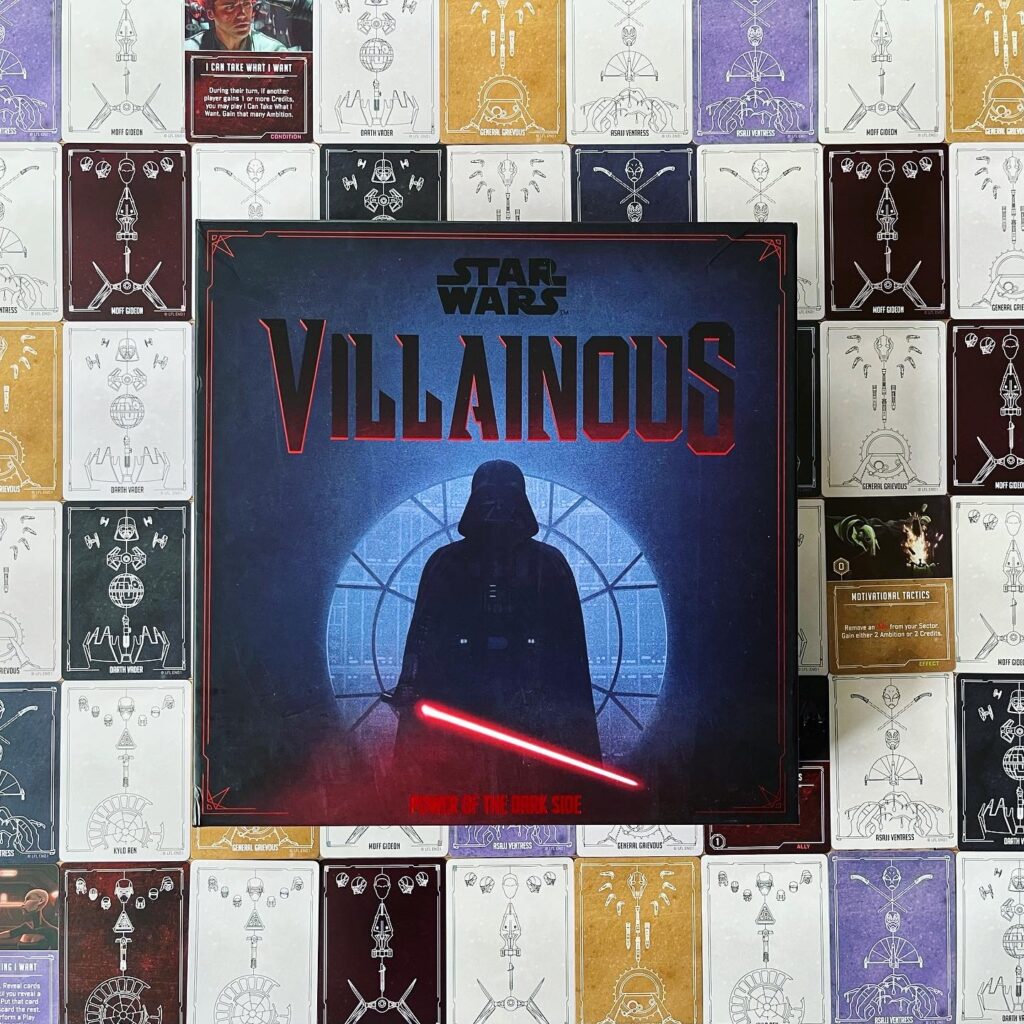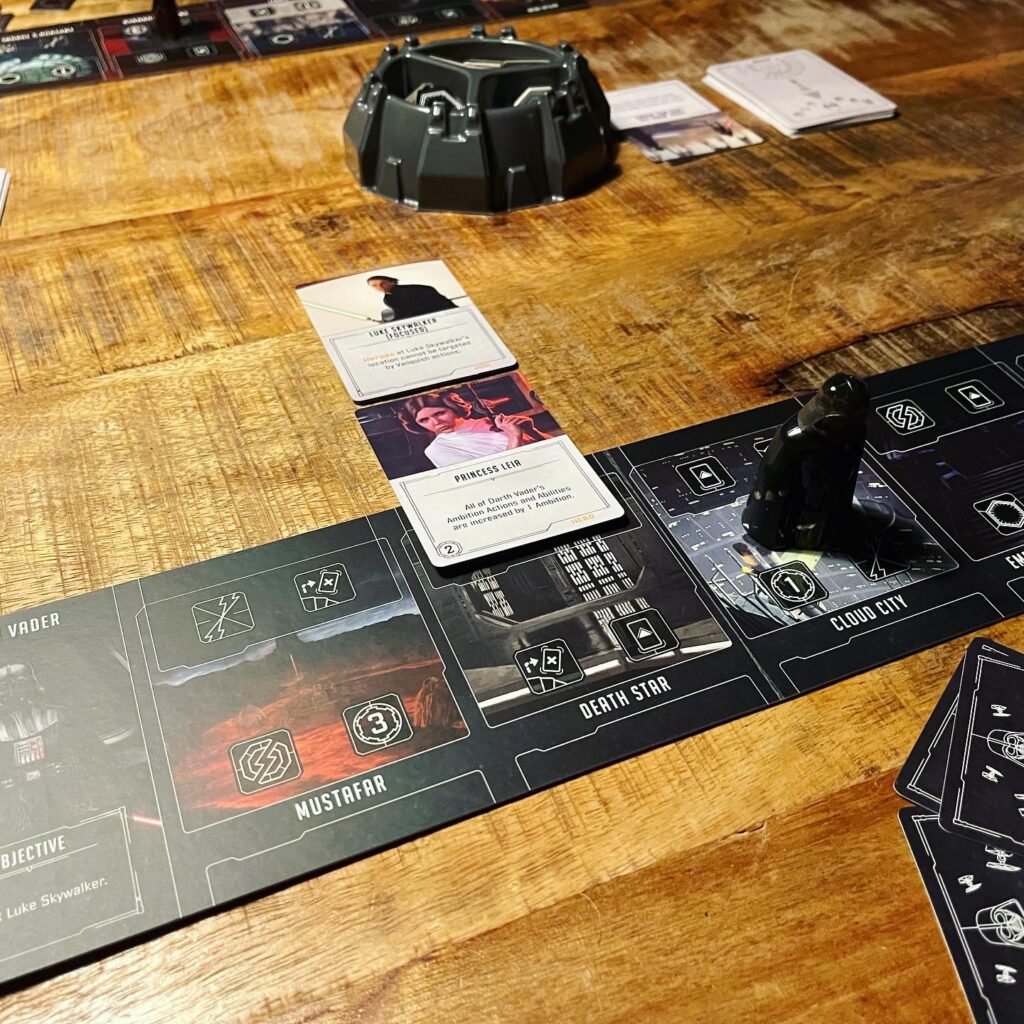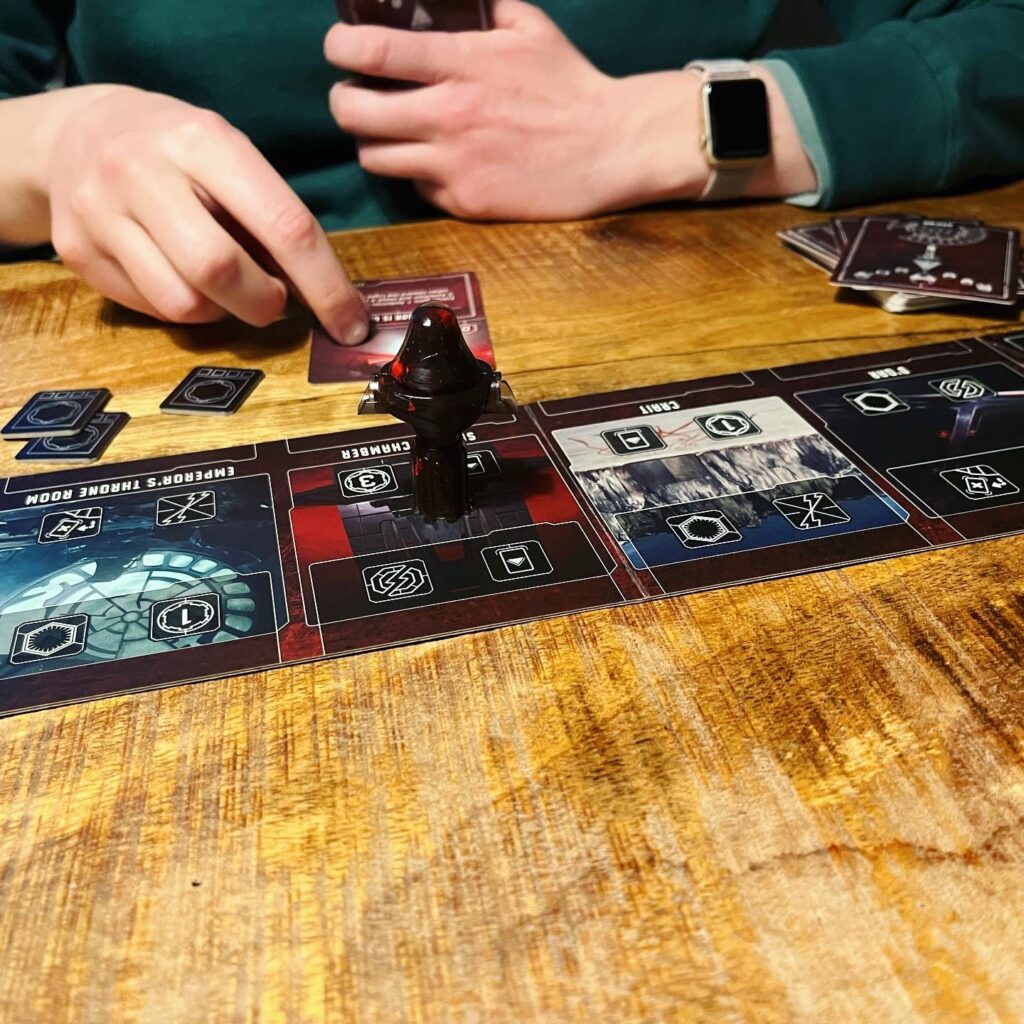“It takes strength to resist the dark side. Only the weak embrace it.” I am weak enough to admit that occasionally it can be nice to play the bad guy in games. Who wouldn’t want to wear the cape of Darth Vader? However, don’t let the evil fears overcome the good, because “Fear is the path to the dark side…fear leads to anger…anger leads to hate…hate leads to suffering.” However, for now: join the dark side!
Background
Villainous is now a regular feature for Ravensburger. After the huge success of Disney Villainous, an asymmetrical game in which each player takes on the role of a villain from a well-known Disney (cartoon) film and this player has to fulfil his own unique goal in order to win, several expansions appeared, allowing each player to play with his favourite villain. A standalone edition, and accompanying expansions, based on the Marvel comic books (and films and games) also appeared. Marvel Villainous was largely similar to the Disney version except that players share the same deck of Fate cards with heroes and events. The Marvel edition, unlike the Disney edition also includes the ability to send minions/goons to the opponent’s player board for some direct interaction.

Meanwhile, Marvel has been an (intellectual) property of the ‘House of Mouse’ for some years now. Also, Star Wars is now part of the Disney empire and has plenty of bad guys. Because of this, a Star Wars Villainous did not appear to be a galaxy far, far away. Like the Marvel edition, Star Wars is a standalone edition that you cannot combine with the Disney edition or the Marvel edition. Star Wars Villainous again has some unique game mechanics compared to the other versions of Villainous.
Goal
For Villainous veterans, I probably only need to explain the differences from the other editions, but for newcomers (or those who could use a refresher): In the Villainous games, each player takes on the role of a well-known villain, baddie or annoyance from very well-known and even very unknown (or partly forgotten) Disney media. In this case, baddies from the Star Wars universe and players take on the roles of either a pair of Sith lords, a Nightsister (and former Sith apprentice), a loyal Moff of the disintegrated former evil empire or a panting android with a goofy accent. The commonality between these villains is their bond (or preference) for the dark side and possession of a lightsaber (or several).
Each villain in Villainous has its own personal goal. Through a handy booklet, players are given explanations of their villain and strategies. In the game, each player tries to be the first to complete his or her nefarious plan to win. How do players fulfil these goals? Usually by playing specific cards or unique actions, but more on that later. First, let’s take a look at how players set up a game.
Set-up
At the start of a game of Villainous, each player chooses one of the available villains, the corresponding player board, a deck of personal draw cards (with a coloured back with symbols unique to this villain and often very descriptive of this villain) and a sturdy plastic pawn. Detail: each villain, as already partly described above, uses (or used to use) lightsabers and these lightsabers are reflected in these stylised pawns. Each player receives their own stack of Fate cards (the white cards), in addition to all the other items mentioned above. These stacks contain heroes, objects, events and vehicles that try to thwart the villain. These Fate cards allow players to influence each other.
Some heroes receive unique game pieces that are used during the game. For example, Kylo Ren receives an extra game board and some tokens to keep track of his position against the Force. Also placed within players’ reach is a three-box tray (The Chamber) with various tokens (credits, ambition tokens and strength tokens). Players draw 4 cards from their personal draw pile and are ready to play after arguing over who gets to start (the player who last used the Force). May the force be with you!
Gameplay
Each player has a personal deck of cards and a player board depicting various actions. Each turn, a player moves his pawn to a different location on the board and may perform the corresponding actions. Often, by using actions, you can collect credits, play cards or use card effects. There are different types of cards. These include allies, which you can play for their special properties and to defeat heroes, and items, to improve allies or other effects again. By taking turns performing different actions and playing cards, you slowly creep towards your goal. The player who fulfils his/her goal first wins.
Players can again hinder each other with Fate cards. When a player performs a fate action, he/she may take a card from this pile and use it, often to the detriment of his/her opponents. Each villain has unique heroes and items that try to stop him or her, and each villain has to get rid of these heroes in a different way.
A key difference from other Villainous games are the different types of cards and currency. Star Wars Villainous has credits (similar to power tokens) to buy ‘regular’ cards with, but each round a player also gets Ambition tokens. You can also get these Ambition tokens through effects of cards, but you also use these tokens to buy Ambition cards with or to activate effects of played cards. To play and use Ambition cards and effects, a new action can be found on the game board. Many goals can only be achieved through sufficient ambition.
Besides the usual types of locations on the game board, there is also a bit of deep space. Players can play vehicle cards to unlock additional locations with unique combinations of actions and special properties every time you move your pawn to this vehicle. Vehicles also appear in the Fate card deck. If you have already played a vehicle, this vehicle of heroes is used to (temporarily) disable the actions on your vehicle. If you have no vehicles of your own, vehicles of heroes allow you to take fewer cards into your hand. Like heroes, you can also defeat vehicles through specific actions on your board.
Villainous villains
What villains are playable this time around? In Star Wars Villainous, you can step into the proverbial skin of Darth Vader, Kylo Ren, General Grievous, Asaij Ventress (from The Clone Wars) and Moff Gideon (from The Mandalorian).



Darth Vader
Darth Vader, as a matter of course, tries to defeat his son Luke Skywalker in order to win Luke over to the dark side. To do this, Darth Vader makes use of an army of Storm Troopers who make each other stronger. Darth Vader starts with a double-sided Luke Skylwaker tile for his game board. Luke has one focussed side and one side with an inner conflict. To defeat Luke, Anakin must take his son to the Emperor’s throne room, play the Emperor card, have Luke on the conflict side and play 6 ambition. If Luke is focussed, heroes in the same location as Luke are unbeatable. If Luke is in conflict, he moves towards the throne every time Darth Vader and his troopers manage to defeat a hero.
Kylo Ren
Kylo Ren hasn’t quite figured out exactly what he wants, but this excitable adolescent with daddy issues has convinced himself that the dark side is superior and your goal is to move some tokens (destiny tokens) to the dark side. To portray this inner struggle, Kylo Ren has a separate game board with a Force track. With ambition, Kylo can move the tokens to the dark can, but heroes like his father Han Solo and his (implied) crush Rey make sure Kylo moves back towards the light.
Asaij Ventress
Asaij Ventress, a nightsister (a kind of witch from the planet Dathomir) and assassin apprentice of Count Dooku, is trying to complete a number of different missions. Asaij has a separate stack of mission cards. The ambition action activates a new mission. Missions are all slightly different and are activated in random order, making every game slightly different. This mechanism personally reminds me a bit of an extended version of Pete from a Disney Villainous set.
General Grievous
General Grievous, hoarder and panting android, is trying to supplement his already fairly generous collection of lightsabers with some extra ones. By defeating Jedi heroes, Grievous receives these lightsabers, but every time he is captured by the Republic army, he loses some swords again.
Moff Gideon
Moff Gideon and his army of already imperial scientists try to experiment on dear Grogu (popularly known as Baby Yoda). To win, Moff Gideon needs to have Grogu, Imperial Sciences Doctor Pershing and some lab samples and enough ambition to make the experiment successful. Moff must, of course, find Grogu first.
Conclusion
Like the other Villainous games, each villain in this Star Wars edition offers another completely different gaming experience. All villains feel unique and very thematic. The different decks of cards contain plenty of references to different Star Wars events and characters, and these are again skillfully and thematically incorporated into the gameplay. As a result, for the Villainous fan and also the Star Wars fan, the game again offers a lot of varied gaming fun. Unfortunately (at the time of writing this review) no expansions to Star Wars Villainous are available yet. I am secretly hoping for Darth Maul, Boba Fett, Thrawn and Jabba the Hutt after all.



